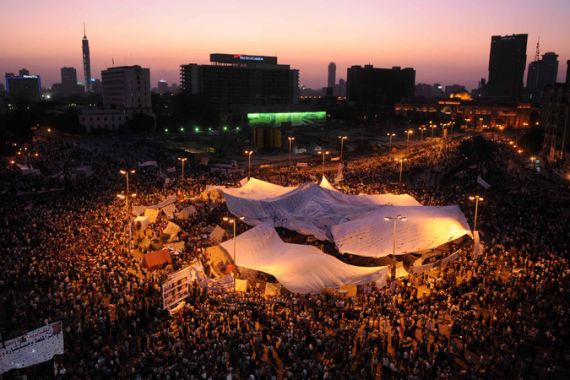New protests rage across Egypt
Demanding faster reforms and prosecution of Mubarak era officials, protesters gather to put pressure on military rulers.

Thousands of demonstrators have flooded Cairo’s now-iconic Tahrir Square and other rallying points across the country to demand immediate reforms and swifter prosecution of former officials from the toppled government of Hosni Mubarak.
Friday’s “March of the Million”, as protesters are calling the new uprising, is expected to be the biggest demonstration since the fall of Mubarak on February 11.
Many Egyptians feel that little has changed since the regime was forced out, and the nationwide protests are the latest calls for the country’s interim military rulers to provide a roadmap towards democracy, jobs and infrastructure improvements.
Most of Egypt’s political parties and coalitions, including the Muslim Brotherhood, supported widespread calls for the protest to be staged across Egypt. Hundreds of protesters gathered in Suez and Alexandria, among other locations.
“The main frustration here is over the release of the officers accused of killing protesters during the revolution is the main focus of the people here,” said Al Jazeera correspondent Sherine Tadros from Suez. “What people here are asking for is justice and faster trials of those responsible for the killings of protesters.
Tadros added that the military is trying to maintain control and show a visible presence in Suez.
“However, they are careful not to overshadow the protesters to make it out in many ways that they are here to stop the protest,” Tadros said.
Five months after the revolution, many activists behind Friday’s protest say few of the goals of the original uprising have been achieved. One rallying point is the claim that military rulers have failed to provide justice for the victims of the former regime.
Call for action
“Punishment for the killers of the martyrs,” read one banner in Tahrir Square, the focal point for protests that drove Mubarak out of office after 30 years in power.
| In video |
|
Shadi Hamid, the Director of Research at the Brookings Doha Center, discusses the issues behind the protests |
Another placard read “Down with the field marshal”, referring to the military commander, Mohamed Hussein Tantawi, who heads the military council which took over after Mubarak.
Tantawi was Mubarak’s defence minister for two decades, and some Egyptians believe he represents the continuation of Mubarak’s lingering power structure that includes the judiciary, police and civil service.
“We want to change everything. The old regime has corrupted everything. We want to change the government and those in charge, the field marshal as well,” Ehab Mohamed Mahmoud, a demonstrator, said.
“The field marshal is an integral part of the old regime,” he said.
More than 840 people were killed in police action in the 18 days leading up to Mubarak’s departure, and protesters complain that many figures from the Mubarak era have yet to be brought to justice.
Yousef Boutrous Ghali, Mubarak’s finance minister, and Rachid Mohammed Rachid, former minister of industry and trade, are on the run from prosecution.
Other members of Mubarak’s inner circle, such as Ahmed Fathi Sorour, ex-parliament speaker, and Safwat El Sharif, secretary general of the former ruling National Democratic Party, are also under investigation.
Other key figures are Gamal and Alaa Mubarak, the ousted president’s sons, and Mubarak’s close confidant Hussien Salam, who has been apprehended in Spain.